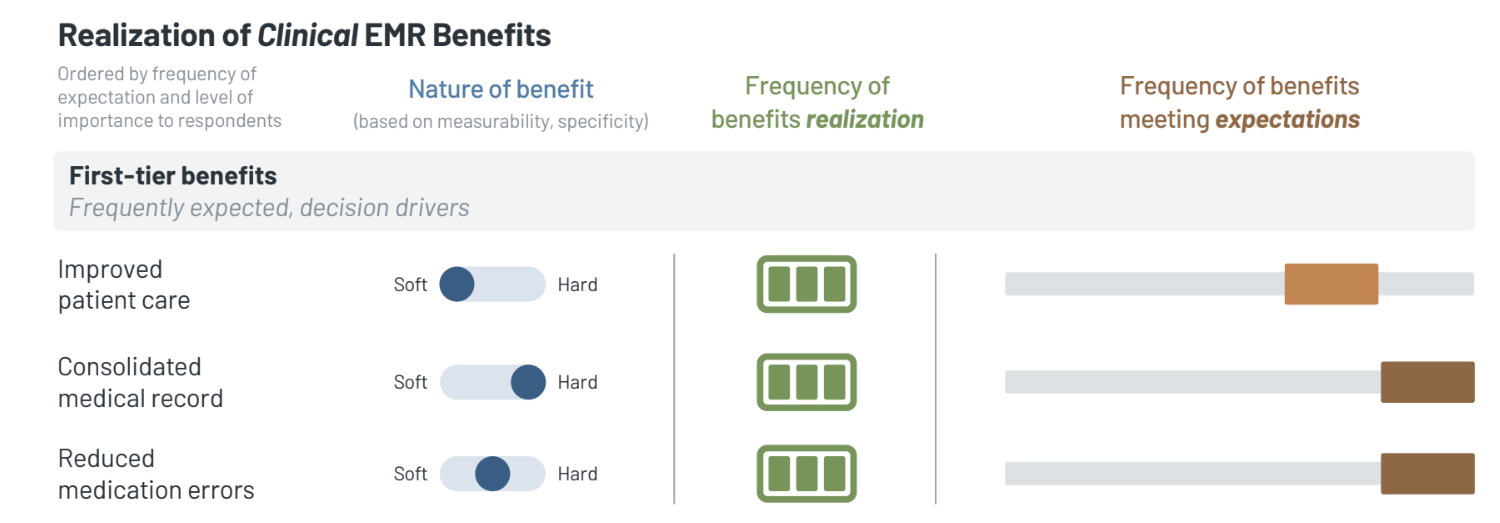
What You Should Know:
- As electronic medical record (EMR) adoption grows worldwide, healthcare organizations considering this digital transformation all have the same question: what benefits can we really expect to receive from implementing an EMR?
- KLAS interviewed leaders at 36 non-US healthcare organizations—12 of which are HIMSS Level 6 or 7—to learn about their journey to realizing benefits from an EMR implementation. Their latest report summarizes their insights, including what clinical and operational benefits they have seen, when those benefits were realized, and what recommendations they have for peer organizations.
Industry Insights into the Expected Benefits From Adoption of the EMR
The key benefits mentioned in the report are as follows:
- Improved Patient Care: Improved patient care is the main overarching clinical goal of an EMR implementation for most organizations. Almost all surveyed said they achieved this, at least in part. Care improvement is realised through a variety of avenues. It was also identified that slower adoption of the EMR can delay full realization of care improvements..
- Consolidated Medical Record and Reduced Medication Errors: It was identified that adoption of electronic medical records allowed most organizations to bring together patient records into single source of truth, thereby creating greater visibility into patient history/care journey and higher patient and clinician satisfaction. Furthermore, order sets, alerts, CDS, and barcoded medication administration help catch issues of high doses, allergies, and other errors
- Use of Clinical Decision Support (CDS): More digitally mature organizations often achieve this benefit, including a related drop in medication errors. About half of respondents have not achieved this as expected, citing the longer-than-expected process to develop databases and set up needed rules and triggers.
- Reduced Sepsis/other HAIs: Multiple organizations report ability to identify sepsis faster because of EMR alerts and triggers. Organizations also see improved visibility into and measurability of HAI rates, which can be difficult to compare to pre-implementation rates. Often varies by vendor depending on strength of sepsis tools.
- Increased Time With Patients: Organizations have mixed opinions of EMR’s effect on patient/clinician care time. Outcome is highly dependent on the individual organization, depending on how efficiency gains are used (i.e., more time with patients versus increasing patient load). For some, electronic charting takes similar time as paper charting, especially in early stages, leading to nonexistent or lower- than-expected gains in clinician time with patients.
The report also included insights into how healthcare organizations can also expect significant financial and operational benefits from their EMR. Increased staff efficiency was identified to be the biggest overarching operational outcome that interviewed organizations expect. 61%–80% achieved this outcome to some degree, particularly when staff members were up to speed with the EMR.
These organizations describe templated clinician documentation, less duplicate documentation, faster intradepartmental communication about orders and results, and automated alerts and notices (which prevent clinicians from having to chase reports). However, just over 60% of surveyed organizations have not achieved the level of efficiency gains they expected. Some say gains were bigger for clinicians than IT personnel; naturally, implementing an EMR increased the IT load, specifically infrastructure management and IT support. Other organizations say EMR documentation still takes a good deal of time, and the number of clicks detracts from expected efficiency gains. Notably, most organizations can only estimate effect on efficiency, which is difficult to concretely measure.
The report concludes by asking the question, “What Can Organizations Do to Achieve More
Benefits from an EMR Implementation?” The advice KLAS gives is two-fold:
- Have a strong plan and vision in place before beginning the implementation
46% of interviewed organizations feel their success was driven mostly by their organization, and 43% say it was achieved in even partnership with their EMR vendor. Across both of these groups, organizations agree they needed to come to the table with a clear understanding of their own needs, unique workflows, and goals and objectives to guide the implementation.
2. Work closely with your vendor partner
Organizations that feel benefits were equally driven by the organization and the vendor were more likely to report clinical and financial/operational benefits, compared to those whose success was primarily organization-driven. One organization described the necessary partnership as one where the healthcare organization can bring ideas to the vendor, and the vendor provides guidance and suggestions on what to do and how to do it. It’s important to select a vendor partner who will work with the organization to understand their specific needs and workflows and implement the EMR accordingly. Some vendors can be more proactive about this type of partnership than others.
